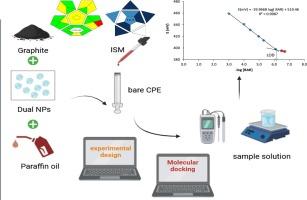A cutting edge potentiometric determination of baricitinib in synthetic wastewater and in tablet dosage form using modified carbon paste ion-selective membrane
IF 4.9
2区 化学
Q1 CHEMISTRY, ANALYTICAL
引用次数: 0
Abstract
After the recent hit of COVID-19, many drugs were successively administered to save patients’ lives and those drugs reached aquatic sources, one of those drugs was Baricitinib. Driven by the current situation, a potentiometric technique using an ion-selective membrane (ISM) recipe drop cast on a modified carbon paste electrode was optimized for the superior determination of Baricitinib (BAR). The molecular docking was customized to optimize the proper ionophores incorporated in the ISM, revealing that beta-cyclodextrin (β-CD) is the most compatible ionophore with the studied drug. A multivariate optimization experimental design was employed to optimize the best experimental condition for the analytical method. To this end; dual nanoparticles (multi-walled carbon nanotubes and copper oxide nanoparticles) were incorporated in the carbon paste electrode, and the ISM recipe was enriched with β-CD and cation-exchanger (phosphotungstic acid) in a polyvinylchloride matrix plasticized with dibutyl phthalate. A Nernstian slope equal to 19.97 mV/decade with a linearity range of 7.99 × 10−7–1.00 × 10−3 M was obtained. The validated sensor exhibited good recovery when used to determine the studied drug in synthetic wastewater and tablet dosage form. The greenness of the method was evaluated using the Complementary Green Analytical Procedure Index and Blue Applicability Grade Index.

利用改性碳浆离子选择膜测定合成废水和片剂中巴利替尼的尖端电位测定法
最近,COVID-19 一炮打响后,许多药物被陆续用于挽救病人的生命,这些药物流入了水产来源,巴利昔替尼就是其中之一。在这一现状的推动下,为了更好地测定巴利替尼(BAR),我们优化了离子选择膜(ISM)配方,并将其滴在改性碳浆电极上。通过分子对接优化了 ISM 中适当的离子载体,发现β-环糊精(β-CD)是与所研究药物最兼容的离子载体。为了优化分析方法的最佳实验条件,采用了多元优化实验设计。为此,在碳浆电极中加入了双纳米粒子(多壁碳纳米管和纳米氧化铜),并在用邻苯二甲酸二丁酯塑化的聚氯乙烯基质中添加了 β-CD 和阳离子交换剂(磷钨酸)的 ISM 配方。得到的 Nernstian 斜率等于 19.97 mV/decade,线性范围为 7.99 × 10-7-1.00 × 10-3 M。在测定合成废水和片剂中的药物时,经验证的传感器具有良好的回收率。该方法的绿色性采用补充绿色分析程序指数和蓝色适用等级指数进行评估。
本文章由计算机程序翻译,如有差异,请以英文原文为准。
求助全文
约1分钟内获得全文
求助全文
来源期刊

Microchemical Journal
化学-分析化学
CiteScore
8.70
自引率
8.30%
发文量
1131
审稿时长
1.9 months
期刊介绍:
The Microchemical Journal is a peer reviewed journal devoted to all aspects and phases of analytical chemistry and chemical analysis. The Microchemical Journal publishes articles which are at the forefront of modern analytical chemistry and cover innovations in the techniques to the finest possible limits. This includes fundamental aspects, instrumentation, new developments, innovative and novel methods and applications including environmental and clinical field.
Traditional classical analytical methods such as spectrophotometry and titrimetry as well as established instrumentation methods such as flame and graphite furnace atomic absorption spectrometry, gas chromatography, and modified glassy or carbon electrode electrochemical methods will be considered, provided they show significant improvements and novelty compared to the established methods.
 求助内容:
求助内容: 应助结果提醒方式:
应助结果提醒方式:


